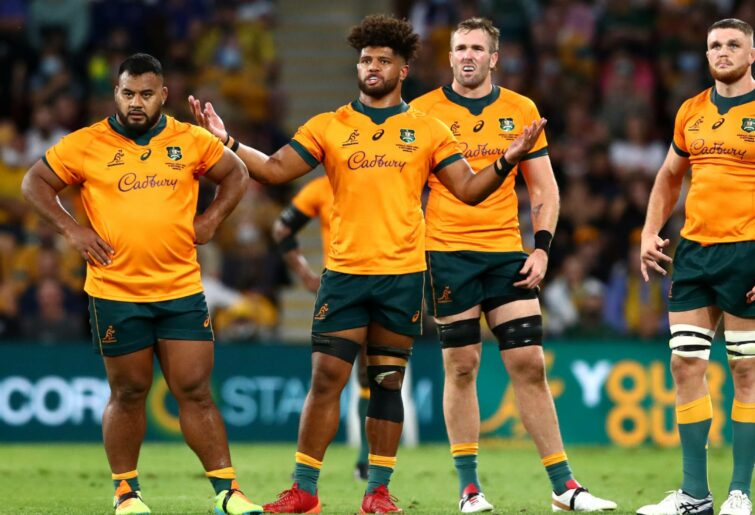Another weekend free of international rugby gave way to another weekend of reflecting on another Wallabies series loss, and all the ifs, buts and maybes that came with it.
It’s not a healthy way to while the time away and in hindsight, watching replays of happier times might have made more sense. I would not necessarily recommend.
But it was partly out of necessity because I was keen to see if my own perceptions through the England series were accurate or if my eyes had deceived me.
As a bit of a recap, in the couple of podcast chats since the third Test in Sydney, I’ve pondered the relatively quiet returns of Rob Leota and Rob Valetini, and in turn wondered whether this was a reason why Michael Hooper’s performance has come under more scrutiny than was perhaps deserved.
My theory being that the lesser performances of Leota and Valetini might have made us look at what was probably another fairly consistently good series from Hooper.
Harry Wilson, I argued – and still believe – was essentially on a hiding to nothing in the Sydney Test. Anything short of the game of his life was going to result in renewed criticism that he doesn’t fit the Dave Rennie method. This is pretty much exactly what has played out, for what it’s worth.
So, watching the match back, I was prepared to have to make a few concessions.
In Sydney, as it was in Brisbane as well, England’s big ball-carriers did their job really well. Ellis Genge was strong, Billy Vunipola just got better as the series went on, and Courtney Lawes was my one and only vote as Player of the Series, with excellent returns on both sides of the ball.
By contrast, the Aussie ball-carriers were just lacking to my live eye’s viewing, so I was ready to be surprised.
But I wasn’t. Sadly, my first instinct was pretty right.
Leota, generally speaking, looked like he hadn’t played much rugby since late May. Valetini didn’t have any of that carnage-generating impact straight up through the central channels, where last year he enjoyed making space and finding offloads for support runners. Andrew Kellaway, from memory, was a keen recipient last season.

Rob Valetini of the Wallabies (Photo by Chris Hyde/Getty Images)
And the numbers confirmed it all, too. While the Australians enjoyed 59 per cent of possession in Sydney, the impact of the forwards when it came to ball carrying was minimal. As was the case throughout the series, Australia’s major ball-carriers were backs.
The backrow lacking punch stands out in all this.
None of the backrowers used carried for more than 2.3 metres per carry, which was Wilson’s return in Sydney, but from just three carries. And over 56 minutes, that’s nearly 19 minutes between runs.
Leota came off the bench in Sydney for eight minutes but didn’t carry at all. Across the series, he carried just eight times, for 1.3 metres each time. And more than 16 minutes in between carries. He also didn’t bust a tackle.
Hooper beat a defender every eight carries at least, but only averaged 1.7 metres each run. His returns might have been a bit down after all.
I do have to concede Valetini was busier than I thought, carrying every 9.6 minutes and busting a tackle every 3.3 carries. I didn’t think his returns were so much better than the others. But again, didn’t break two metres per carry.
None of these numbers scream ‘gain line’ though, and that’s why the Wallabies played so much off the back foot, despite having so much more ball in Sydney than they did in Brisbane and Perth.
And this has to be a huge focus before departing for Argentina later this week.
It’s all fine and good for likes of Samu Kerevi and Marika Koroibete and Tom Wright to do a bit of damage with ball in hand, but it can’t come out of desperation after the forwards initially got nowhere.
It’s all fine and good to want the best maul in the game, but it tends to lose a bit of edge when it’s back trying to get over the 22, rather than the tryline where it wants to be.
As much as their execution errors and decision-making let them down in so many crucial moments in Sydney, the fact that they had to attack from so far out was part of the problem. For all the possession they enjoyed, the Wallabies still had less than half the share of territory in the third Test.
So it will be interesting later in the week to hear them speak of what areas they’ve been focussing on prior to getting on the plane. The attack focus can only get the results wanted if the ball carriers up-front are making ground, and it’s a whole lot easier to attack with momentum in the right part of the field.
Ireland showed the virtue of patience throughout their outstanding series win in New Zealand, and were prepared to wait until they were in the right part of the field before launching their dual-sided attack designed to isolate the All Blacks’ front rowers in defence.
But you can’t do that without carrying well and kicking smartly from further upfield.
The Wallabies – like they’ve done for too long – showed that they’re capable to playing the long game to set up their attack.
And it has to start with the backrow punch in Argentina. So much of their game that didn’t quite fire in the England series can still have an impact and form a big part of the attack through the Rugby Championship.
It’s just going to need a lot more output up-front.





























































































